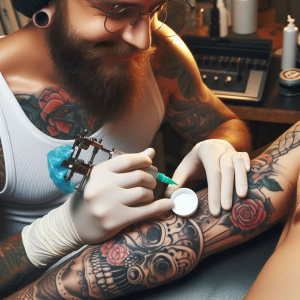Numbing creams used for tattoos are specifically designed to reduce pain felt during the receiving of tattoos, hence making the process much more bearable. The creams are active with chemicals like lidocaine, a local anesthetic. Lidocaine inhibits nerve impulses carrying pain signals to the brain, causing the skin that it touches to become numb. This is very helpful during receiving large tattoos or tattoos in areas that are sensitive.
How Does Lidocaine Make a Difference in Tattoo Numbing Cream?
Lidocaine is among the most widely used anesthetics in the field of medicine, ranging from minor surgery to dentistry. Its effectiveness in tattoo numbing creams is due to its capacity to suppress pain receptors on the skin for a temporary duration.

Upon application to the skin, it permeates and leaves a numbing sensation, enabling tattoo artists to work more precisely while providing a less painful experience for you.
Why You Should Think About Using Numbing Cream on Your Tattoo?
Tattooing can be a painful process, particularly for beginners or those who opt for tattoos on sensitive areas such as the ribs, spine, or elbows. The use of a numbing cream eliminates the pain to a great degree, making the process less difficult. Numbing creams with lidocaine allow you to minimize the pain without eliminating the sensation of the tattoo work. This might be especially helpful for long sessions or in intricate designs.
What Are the Benefits of Using Lidocaine in Tattoo Numbing Cream?
The use of lidocaine in tattoo numbing creams has several benefits:
- Decrease in Pain: Lidocaine is effective in numbing the skin, reducing the pain of the tattooing process.
- More Sessions: For tattoos requiring longer sessions, numbing creams containing lidocaine allow you to remain comfortable and relaxed throughout.
- Faster Healing: Reduced trauma to the skin during the tattooing process can help in quicker healing post-session.
- Accurate Work: Numbing cream allows the artist to concentrate on fine details without any fear of pain interrupting the work.
How to Apply Tattoo Numbing Cream for Maximum Effectiveness?
Proper application of tattoo numbing cream is important to get the best results. Here’s a step-by-step guide to applying it effectively:
- Clean the Area: Wash the area where you’ll get the tattoo thoroughly with mild soap and water. Dry it gently.
- Use the Numbing Cream: Use a thick layer of numbing cream on the skin where the tattoo will be performed. Make sure to cover the area uniformly.
- Wrap the Area: Wrap the cream with plastic wrap. This allows the cream to penetrate the skin better and keeps the cream moist.
- Wait for It to Set In: Have the numbing cream on your skin for 20-30 minutes, or as directed by the manufacturer. The cream will numb the skin during this time.
- Clean Away the Cream: Clean away the cream before your session begins and prepare the skin for tattooing.
Are Side Effects or Hazards of Using Numbing Cream?
Numbing creams are safe to use but have some side effects, mostly if inappropriately used or in excess. Redness of the skin, irritation of the skin, and allergic reactions to the skin might be experienced in some people who use the creams, but they are not typical. A patch test is always necessary prior to applying the cream to an entire area. On top of this, strictly follow the guidelines on the label of the product to avoid experiencing any negative effects.
When Should You Not Use Tattoo Numbing Cream?
There are certain occasions when you must not use numbing cream. Do not use numbing creams if you have sensitive skin, eczema, or have any form of open wounds on the area of skin where you are to receive the tattoo. Numbing creams should also never be applied to broken or swollen areas of the skin. You should always consult a healthcare professional if you need information about how to use numbing creams.
What Are the Best Tattoo Numbing Creams on the Market?
Not all numbing creams are created equal. When shopping for a numbing cream, look for one that contains a high concentration of lidocaine. Some popular and effective numbing creams contain lidocaine concentrations ranging from 4% to 5%. It’s important to select a product that is specifically designed for tattoo use, as some numbing creams are made for other uses, like dental or medical procedures.